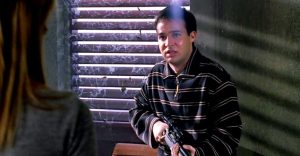Dirty Money: What Netflix’s Documentary Leaves Out About Wells Fargo

The Wells Fargo accounts fraud fiasco is the focus of the second season premiere of Netflix’s original documentary series Dirty Money, but the show doesn’t tell the whole story. From its origins in the stagecoach business (which it has carried on as part of its branding into the present) to the comparatively risk-averse practices that allowed it to survive the Great Recession relatively unscathed, Wells Fargo had a reputation for being straightforward, steadfast, and sensible. That all changed in 2016 when the Consumer Financial Protection Bureau fined the banking giant $185 million, calling national attention to reports that had been surfacing for several years regarding the toxic, cutthroat culture concealed behind the company’s folksy, all-American image.
According to these reports, the company exerted enormous pressure on individual branch employees to meet lofty sales quotas through cross-selling, an industry term for getting customers to purchase multiple products from one institution in order to ensure their continued patronage. In Wells Fargo’s case this meant encouraging new or existing clients to open multiple accounts, but the aggressive and unforgiving company culture resulted in branch employees – desperate to meet their quotas – opening fraudulent accounts through forgery and otherwise manipulative behaviors.
Dirty Money details these practices, which included encouraging employees to open credit cards without customer consent, solicit their friends and family to open numerous redundant accounts, and take advantage of non-English speaking customers using loopholes in the private arbitration process. Several former Wells Fargo employees-turned-activists are extensively interviewed, and the episode’s narrative is structured around their experiences. However, there’s a lot more to the story than what these individuals recount.
Navajo Nation vs. Wells Fargo

In 2017 the Navajo Nation filed a lawsuit against Wells Fargo in both tribal and federal courts, accusing the bank of having specifically targeted and taken advantage of some of the community’s most vulnerable members. According to the Huffington Post, the suit alleges that Wells Fargo employees misled non-English speaking elders by refusing to cash their checks unless they opened Wells Fargo savings accounts. The bank was ordered to pay $6.5 million in damages – a miniscule sum for the enormous bank – to the Navajo Nation in August of 2019. Dirty Money covers other instances of Wells Fargo having exploited language barriers, such as allowing branch employees to translate on behalf of Spanish-speaking customers when opening their accounts yet refusing to allow these same clients to report wrongdoing without hiring their own interpreter, but the bank’s legal battle with the Navajo community went untold.
Wells Fargo Wrecks Resumes

Dirty Money touches on the enormous relief and vindication felt by fired Wells Fargo employees once word of their former employer’s toxic culture hit mainstream media. Employees who had been fired for failing to meet their quotas were comforted to know that the problem was with Wells Fargo and not them, and were relieved that friends and family would finally understand what went wrong with their employment. The former employees profiled in the Netflix docuseries were, for the most part, individuals who protested against their former employer and advocated for the rights of bank employees. However, despite their best efforts, thousands of other fired staffers are still having difficulty finding work despite widespread revelation of the company’s unforgiving atmosphere and blatantly fraudulent practices. According to WSJ, employees Wells Fargo fired have permanent black marks on their public records, and the process for disputing them is arduous – requiring time, money, and resources that the average out-of-work bank employee necessarily lacks.
It’s Not Just Wells Fargo

Dirty Money emphasizes Wells Fargo’s formerly squeaky-clean, friendly image compared to the manifestly cold, alienated reputation of comparable institutions in order to emphasize the ruthless and predatory practices that went on behind Wells Fargo’s closed doors. It should therefore come as no surprise that Wells Fargo was hardly the only bank to use such tactics to boost their numbers and appear more successful than they were, but Dirty Money fails to mention that consumers may be at risk of such manipulation even today, even at other banks. According to a Reddit user who cites a decade of experience working in banking, the exact same manipulative sales tactics and outright fraud committed by Wells Fargo and scrutinized in Dirty Money are commonplace at other banks. The show takes care to point out that cross-selling is so widespread in the financial world that banks receive “trust ratings” based on their cross-selling ratio, but fails to mention that these numbers are by and large inflated reflections of the same unsavory practices that led to Wells Fargo’s falsely stellar reputation and subsequent fall from grace.
Ironically, Wells Fargo’s emphasis on its origins in Westward Expansion – which was intended as folksy and wholesome – resonates unfortunately well with the bank’s contemporary mistreatment of the Navajo community. The callous dismissal of employees whose fraudulent practices were the direct result of an aggressive company culture of which top-level executives refused to take ownership has continued to haunt those former employees to this day. That Wells Fargo is not alone in encouraging active defrauding of its customers is unsurprising given that its peer institutions tanked the global economy in the late 2000s as a result of similarly skewed priorities. Just because Wells Fargo wasn’t specifically blamed for the Great Recession, doesn’t mean it values its customers above its bottom line. These ills are industry-wide.
Dirty Money does a good job of summarizing the Wells Fargo scandal for those who remember hearing about it in the news but didn’t necessarily know the details. By heavily emphasizing the enormous value the bank placed on its heritage and image, audiences unfamiliar with the world of finance get a real sense of why this particular banking scandal stands out among the rest. Wells Fargo was seen as nothing if not trustworthy; its entire branding strategy was, essentially, “we’re not like other banks.” To learn that it was, in fact, exactly as deceitful and bottom-line driven as other similar financial institutions was a surprise to even those most entrenched in the world of high finance. However, the series leaves out or glosses over information that places the scandal in meaningful institutional and historical context.
About The Author

















